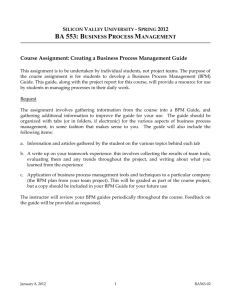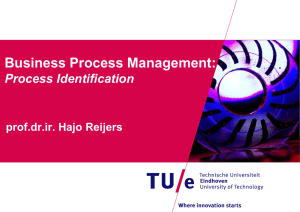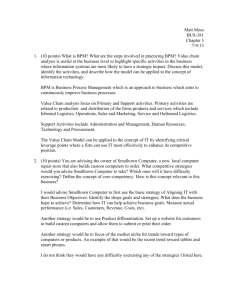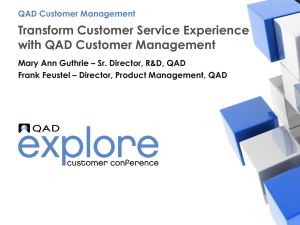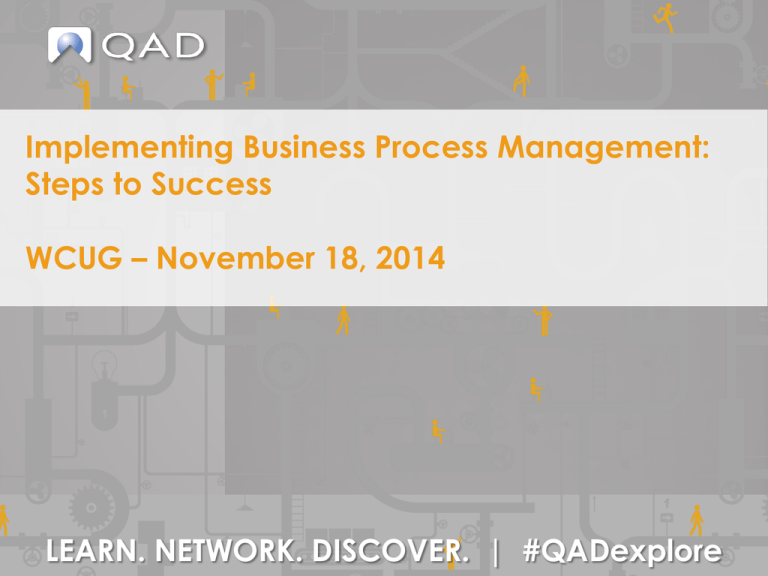
Implementing Business Process Management:
Steps to Success
WCUG – November 18, 2014
LEARN. NETWORK. DISCOVER. | #QADexplore
Implementing Business Process Management: Steps to Success
Safe Harbor Statement
The following is intended to outline QAD’s general
product direction. It is intended for information
purposes only, and may not be incorporated into
any contract. It is not a commitment to deliver
any material, code, functional capabilities, and
should not be relied upon in making purchasing
decisions. The development, release, and timing
of any features or functional capabilities
described for QAD’s products remains at the sole
discretion of QAD.
2
Implementing Business Process Management: Steps to Success
Agenda
First … A Quick Update
Six Implementation Phases
Assess
Design
• BRDs
Model
Implement
Monitor
Modify
3
First … A Quick Update
LEARN. NETWORK. DISCOVER. | #QADexplore
Implementing Business Process Management: Steps to Success
Business Moments: Transient Opportunities
Exploited Dynamically
5
Implementing Business Process Management: Steps to Success
BPM 2.0 (September 2014)
•
•
•
•
•
Replace Biz Rules with Corticon
Simulation
Add New Supply Side Processes
Easy-On-Boarding Integration
Embedding BPM to OpenEdge
6
Implementing Business Process Management: Steps to Success
Corticon
Better, faster decisions by
automating business rules
Patented “no-coding”
rules engine
• Automate manual decision
making processes
• Transform inflexible legacy
system processes
• Reduce development and
change cycles by 90%
• Rules integrity technology
guarantees accurate results
Define and Determine Results
Adapt Quickly to Changing Market Conditions
7
7
© 2011 Corticon Technologies, Inc. All rights reserved. - Confidential
Implementing Business Process Management: Steps to Success
Corticon Rules Engine
8
Implementing Business Process Management: Steps to Success
9
Implementing Business Process Management: Steps to Success
Simulation
10
Implementing Business Process Management: Steps to Success
Customers
11
Six Implementation
Phases
LEARN. NETWORK. DISCOVER. | #QADexplore
Implementing Business Process Management: Steps to Success
It’s All About Processes
Type of Process
Direct
Value/Core
Solution
Enterprise
Applications
Enterprise
Applications
Indirect Value/
Support
QAD BPM
13
Implementing Business Process Management: Steps to Success
14
Implementing Business Process Management: Steps to Success
Readiness Assessment
Are your processes clearly defined?
How were they defined?
What tools or approaches were used?
How do you currently manage your
processes today?
Is the indirect organization really ready for
process automation?
15
Implementing Business Process Management: Steps to Success
Implementation Methodology
16
Implementing Business Process Management: Steps to Success
QAD BPM
17
17
Project Commitment
Form Core BPM Process
Project Team
Continuously Adapt
And Promote Success
Assess
Modify
Design
Iterate
Monitor
Model
Implement
18
Implementing Business Process Management: Steps to Success
Assess
1. Assess
”Capturing business intent through documenting and
creating basic models for the business goals,
objectives, and strategy.”
19
Implementing Business Process Management: Steps to Success
Sample Selection Criterion
1. Assess
• Clear and direct linkage to management
objectives
• Consider value of process to business and its
health
• Focus on eliminating a key system
constraint.
20
Implementing Business Process Management: Steps to Success
Mapping “As-Is”
1. Assess
• Discover process issues in organization
• Uncover structural problems, poor controls, and
people issues
• Define cause of quality and inefficiency issues
• “As-Is” or current state scenario
• Trying to describe
-
What takes place
Who does each task
How long
How frequently
Error types
Costs
21
Implementing Business Process Management: Steps to Success
Design
2. Design
• Current or “as-is” state from assessment
phase + interviews + gap/root cause
analysis = what process should be
• Focus on business need and how processes
and associated workflows can best meet
need
• Reduce number of problems over lifetime of
process
• Link to outcomes
- Improve customer satisfaction, decrease costs or
cycle times, or increase service level agreement 22
achievement
Implementing Business Process Management: Steps to Success
Evaluating Design Options
2. Design
• Solve business problems
• Ensure that a correct and efficient
conceptual design is prepared
- Multiple options
• Customer needs well understood and
achieved
• When needs vary, process allows flexibility
23
Implementing Business Process Management: Steps to Success
BRD: Business Requirements Document
2. Design
Process as a Whole
− Process Owner
− Purpose
− Customer
Each Activity
−
−
−
−
Roles
Resources
Data
Duration
Other BRD Considerations
− Business Dependencies & Constraints
− Training
− Acceptance Test Strategy
24
Implementing Business Process Management: Steps to Success
Model
3. Model
• BPM results in change
• Want to ensure changes are positive –
mistakes are costly
• Process changes can be very disruptive –
understanding impacts and benefits (or
flaws) prior to implementation makes it
easier to communicate and gain
acceptance (or avoid)
• Part of evaluation and decision process
25
Implementing Business Process Management: Steps to Success
Simulation
3. Model
• Can be simple … a series of diagrams on a
whiteboard and a paper-based run-through
of a scenario
• Benefits:
-
Analyze modeling scenarios faster
Effective use of limited resources
Improve team productivity
Help to understand critical process attributes
Assist in modification of attributes
Provide visual feedback for rapid assessment
Help and help to increase customer satisfaction.
26
Implementing Business Process Management: Steps to Success
Implementation Phase
4.
Implement
• Installing new process
• Requires very detailed change
management planning
• Coordination with all stakeholders
• System changes
27
Implementing Business Process Management: Steps to Success
Implementation Plan Schedule
4.
Implement
28
Implementing Business Process Management: Steps to Success
Monitor
5. Monitor
• Post-execution optimization is based on
analysis of actual as-performed metrics (live
data)
• Key performance indicators (KPIs), data,
and qualitative measures
- Worker feedback
- Surveys
• Link to design objectives
• Browses, alerts, business rules and escalation
mechanisms validated in real life.
29
Implementing Business Process Management: Steps to Success
Business Motivations
5. Monitor
• Balancing profit, growth, and control
• Balancing short-term results against longterm capabilities and growth opportunities
• Balancing performance expectations of
different constituencies
• Balancing opportunities and attention
30
Implementing Business Process Management: Steps to Success
Modify Optimization
6. Modify
Data analyzed from KPIs and current activity
monitoring
Trends and associated impacts from other
processes
Process bottlenecks are identified
Goal is to move process inefficiency to an
efficient and balanced process that supports
Modification
defined KPIs Considerations
Time Frame
Scope
31
Implementing Business Process Management: Steps to Success
Summary
• BPM v2
• Six Steps
-
Assess
Design
Model
Implement
Monitor
Modify
Project Commitment
Form Core BPM Process
Project Team
Continuously Adapt
And Promote Success
Modify
Assess
Design
Iterate
Monitor
Model
Implement
32
Questions?
33
LEARN. NETWORK. DISCOVER. | #QADexplore
Save the Date for
Explore 2015
www.qad.com/explore

